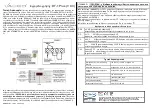
Hardware
10
SLAU772 – June 2018
Copyright © 2018, Texas Instruments Incorporated
MSP430G2553 LaunchPad™ Development Kit (MSP
‑
EXP430G2ET)
On the host side, a virtual COM port for the application backchannel UART is generated when the
LaunchPad development kit enumerates on the host. You can use any PC application that interfaces with
COM ports, including terminal applications like Hyperterminal or Docklight, to open this port and
communicate with the target application. You need to identify the COM port for the backchannel. On
Windows PCs, Device Manager can assist.
Figure 7. Application Backchannel UART in Device Manager
The backchannel UART is the "MSP Application UART1" port. In this case,
shows COM13, but
this port can vary from one host PC to the next. After you identify the correct COM port, configure it in
your host application according to its documentation. You can then open the port and begin
communication to it from the host.
On the target MSP430G2553 side, the backchannel is connected to the USCI_A0 module. The eZ-FET
has a configurable baud rate; therefore, it is important to configure the baud rate of the PC application to
the same rate as the USCI_A0.
2.3
Power
The board was designed to accommodate various powering methods, including through the onboard eZ-
FET as well as external or BoosterPack plug-in module power (see
Figure 8. MSP-EXP430G2ET Power Block Diagram
2.3.1
eZ-FET USB Power
The most common power-supply scenario is from USB through the eZ-FET debugger. This provides 5-V
power from the USB and also regulates this power rail to 3.3 V for eZ-FET operation and 3.3 V to the
target side of the LaunchPad development kit. Power from the eZ-FET is controlled by jumper J101. For
3.3 V, make sure that a jumper is connected across the J101 3V3 terminal.











































